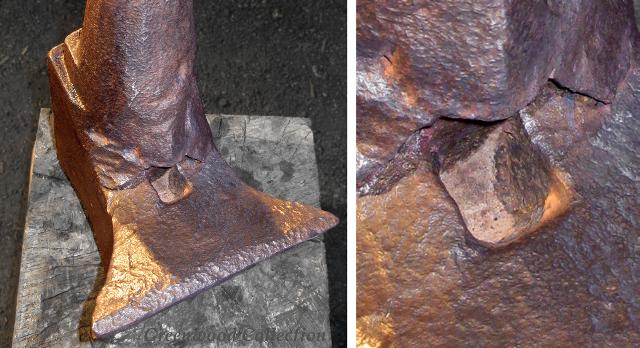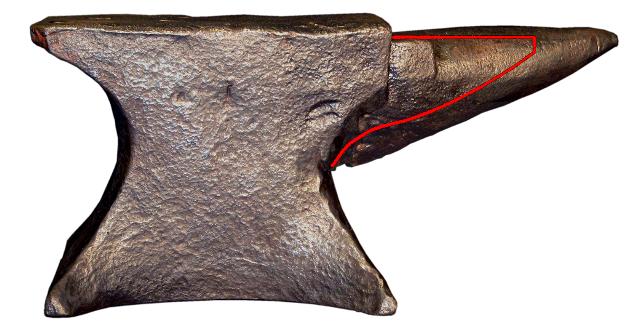From the Josh Greenwood Collection
This old anvil has the typical hand modeled lines of 18th Century English anvils.
Unmarked, it could have been made by any one of a hundred English anvil makers.
Besides the repairs it also has the typical wear from a hundred years of continous use includihng the face being worn through.
The replacement horn shows wear from making thousands of the same parts, possibly horse shoes.
 Broken horns are fairly common on early anvils as they were butt welded to the front of the anvil.
It was a sommon enough problem that there are several articles in Richardson's Practical Blacksmithing on replacing horns, often by mechanical methods.
There are also several myths and stories about broken anvil horns.
Broken horns are fairly common on early anvils as they were butt welded to the front of the anvil.
It was a sommon enough problem that there are several articles in Richardson's Practical Blacksmithing on replacing horns, often by mechanical methods.
There are also several myths and stories about broken anvil horns.
In this case an oversize replacement horn was made and welded on.
The forge weld under the horn did not stick well leaving a ragged edge.
It also nearly overlaps the handling hole which was normally kept clean and clear despite the contours in this area.

The red line shows the normal small horn on the average anvil from this era that would be proportionally correct for this anvil.
At some time a pritchell hole was drilled, possibly when the repair was made.
Drill marks can be seen in the pritchell hole and it is much closer to the corner than is normal.
This anvil is worn and well used.
Even with the early damage it has outlived its makers and possibly a dozen generations of owners.
Marks : N/A
Age : 18th Century, Repaired in the 18th or 19th Century.
Weight : Approx 200 lbs. (~90 kg)
The unusual color of the photos is due to the sodium lights in the shop.

Photo of anvils and tools at Greenwood Ironworks
Collection of Colonial anvils at Greenwood Ironworks photographed in 2009.






This old anvil has the typical hand modeled lines of 18th Century English anvils. Unmarked, it could have been made by any one of a hundred English anvil makers. Besides the repairs it also has the typical wear from a hundred years of continous use includihng the face being worn through. The replacement horn shows wear from making thousands of the same parts, possibly horse shoes.
The Repair
Broken horns are fairly common on early anvils as they were butt welded to the front of the anvil. It was a sommon enough problem that there are several articles in Richardson's Practical Blacksmithing on replacing horns, often by mechanical methods. There are also several myths and stories about broken anvil horns.In this case an oversize replacement horn was made and welded on. The forge weld under the horn did not stick well leaving a ragged edge. It also nearly overlaps the handling hole which was normally kept clean and clear despite the contours in this area.

The red line shows the normal small horn on the average anvil from this era that would be proportionally correct for this anvil.
At some time a pritchell hole was drilled, possibly when the repair was made. Drill marks can be seen in the pritchell hole and it is much closer to the corner than is normal. This anvil is worn and well used. Even with the early damage it has outlived its makers and possibly a dozen generations of owners.
The unusual color of the photos is due to the sodium lights in the shop.
Photo of anvils and tools at Greenwood Ironworks
Collection of Colonial anvils at Greenwood Ironworks photographed in 2009.